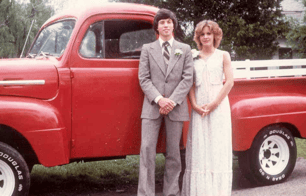
Kimberly V. Althage – October 7, 2021
One thing that is consistent for every vehicle at Gateway Classic Cars is their story. Every one of our automobiles represent moments and/or milestones in peoples’ lives. Our favorite part of what we do is our ability to tell that story. Occasionally, we come across a vehicle’s story (or history) which truly defines our slogan ‘Where Dreams Are Driven’ in the most apt manner. When this vehicle arrived at our St. Louis showroom, we were humbled when the owner shared the story of this 1951 Ford F100. We now seek a new owner who will embrace and appreciate everything that went into making this restoration a reality.
This 1951 Ford F100 pickup has lived many lives and is truly unique. It began when Doug Lilly’s father thought restoring an old truck would be a great family project and bonding experience with his boys. In 1975, Doug and his older brother, Dave, got an old gray 1951 Ford F100 pickup to restore together. Doug and his father did the body work and painted the old truck bright red while Dave rebuilt the flathead V-8 engine.
In 1981, the family moved to California. Initially this truck sat in the barn for a while, and then it languished in the elements on the back of their 35 acre property. There it sat, getting older and rusty. The truck spent 20 years standing in a field in Dansville, sinking into the ground up to its frame.
Decades later, Doug’s son Justin Lilly was about 13 and he decided he wanted to restore the truck and he started pestering his dad about it. Doug remembered the work it took when he and his brother did so decades previously. His father had passed away, but if Justin’s maternal grandfather was on board, he would haul the old truck over to his father-in-law’s barn for them to work on it together.
Progress was slow those first couple of years. First, the truck was in woeful shape, and 1951 Ford truck parts were hard to find. Justin and his grandfather got the wheels to rotate again and replaced the brakes. They bought a new engine and were beginning the bodywork when it became apparent that the condition of Justin’s lungs would keep him from participating in every aspect of the build. Justin could not complete the body work on the truck because of how the chemicals in the body paint affect his breathing.
Justin was born premature, and as a result, developed Bronchopulmonary Dysplasia (BPD), or sometimes referred to as chronic lung disease. Babies born prematurely are at risk of BPD, which is a form of lung disease that can drastically reduce lung capacity due to an abnormal development of the lung tissue. Justin’s lungs did not grow to their full capacity and his reduced lung capacity meant that working with solvents and chemicals was out of the question.

When he was 16, Justin’s doctor referred him to another specialist, anticipating a lung transplant. Instead, the new doctor suggested physical therapy to strengthen Justin’s lungs. An administrator where Justin was doing his therapy remembered him from when he was a little boy and told the family that Justin was eligible for a wish from the Make-A-Wish Foundation of Michigan. Once approved, Justin made his wish to have the truck painted.
The Michigan chapter of Make-A-Wish Foundation tirelessly searched for a shop able to dedicate the time and resources necessary to make Justin’s wish come true. For two years they looked, never giving up. True to their promise, they finally found Washtenaw Community College (WCC). WCC’s Auto Body Repair department and its Custom Cars and Concepts department had the facilities necessary, so it took the job.
In December 2005, the Lillys received a call from Make-A-Wish about the good news. The call was in the nick of time, for their exhaustive searching almost meant Justin would age out of the program. They informed the family that the automotive services department at Washtenaw Community College was interested in working on the truck – and not just painting it.
Gary Sobbry, WCC instructor and adviser, and the 50 so-called gearheads he instructs at the Washtenaw Community College Custom Cars and Concepts Department, offered their resources and expertise. WCC is a rarity. It is one of the few college trade schools that teach automotive customizing. WCC is one of the top automotive colleges in the country where its teachers and students build high-end customs, hot-rods, and muscle cars from the ground up. Their clients include General Motors, Ford, and Chrysler.
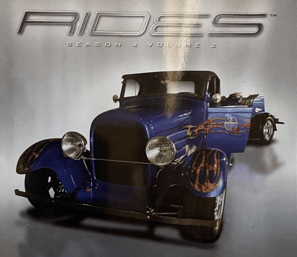
“The majority of cars we build are for rich people and usually sit in garages or museums for extended periods,” Sobbry said. “What made this so appealing was the fact that it was a great opportunity to do some real good for another person. The truck looks like it’s been sitting in a junkyard or a farmer’s field for about 100 years,” he said. “We’re basically going to build the baddest ’51 Ford truck that’s ever roamed the streets.”
Perhaps kismet, around this time Justin and his father were watching an episode of Rides, a weekly American docuseries on TLC. The weekly TLC cable series was a celebration of “tricked-out dream machines” and the people who build them. They just happened to be watching a rerun of the episode ‘Summer School’ featuring WCC working on a 1970 Chevelle SS convertible. As they watch, Doug tells his son, “I just spoke to that guy [Sobbry] earlier today.”
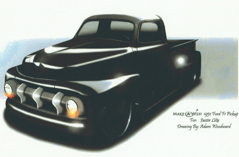
A mere two days before Justin turned 18, a crew from WCC took the truck from Justin’s grandparents’ home. They transported it to WCC in Ann Arbor, where automotive professors and students would finish the restoration and extreme makeover. The students at WCC encouraged Justin to expand his idea of what the truck could be.
The Make-A-Wish Foundation’s $5,000 maximum allotment to make a wish come true for someone with a life-threatening medical condition was not enough. The budget of the build caused some hurdles and the work had to be put on pause a few times when money ran short.
WCC students spent hundreds of hours fundraising and researching parts. In total, they spent 18 months volunteering to fulfill the Lilly’s dream as manufacturers donated parts or sold parts for costs or less. WCC students raised more than $30,000 – $5K from Haggerty Insurance Agency, plus a handful of private donations, and begged for an additional $100K in parts, including Ford Motor Company’s donated $40K drivetrain that includes a 4.6-litre, 608-horsepower prototype racing engine. The engine had its own unique history.
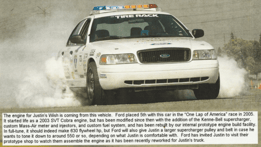
Its engine was one of those underground projects that was never officially approved, the sort of thing that is done on personal time through sleepless nights. Its origin is when Ford Motor Company entered a heavily modified 2004 Crown Victoria Police Interceptor to run in the One Lap of America. It was driven by a team of engineers and technicians including specialists in powertrain, tires, and handling. The primary driver was Dan Haakenson, Ford Tire Technical Specialist.
What is One Lap of America?
The One Lap of America started off as an entirely scofflaw event organized by CAR and DRIVER editor Brock Yates in 1971. Originally called the Cannonball Baker Sea-To-Shining-Sea Memorial Trophy Dash, it was a non-stop run from New York City to Redondo Beach, CA. Those 2,800 miles were completed in 33 hours for an outrageously illegal average of 85 mph! This event became the basis for the movies, Cannonball and Cannonball Run.
In 1989, the event went legit with a series of road rallies and autocross events held across America. A requirement then and now, is the driver drives the car between the cities on the tour, no trailers are allowed, and safety laws are observed. Therefore, it is still an automotive marathon that challenges car builders to build a vehicle capable of driving their cars in a grueling road trip with stops at racetracks along the way. The span of 3,100 miles in eight days and serious racing each day captures the spirit of the original non-stop Cannonball.
Other changes brought by going legitimate is that all racing is done on sanctioned racetracks. In addition, all drivers are required to complete two driver’s schools or the equivalent to a Sports Car Club of America “regional” driver’s license. Unlike the original Cannonball, traffic violations along the One Lap route that result in a conviction will disqualify a competitor.
The engine for Justin’s truck was originally used in Ford’s Team Panther CVPI One Lap of America entry. Rather than demolishing the prototype engine, Ford generously donated it to the project. It is a modified 4.6-liter DOHC Cobra Terminator 32-valve V-8 engine, fed by a Kenne Bell twin-screw supercharger delivering 15-psi max boost, 535 rear-wheel horsepower, and 550 pound-feet of torque and a K&N air induction system. The crank horsepower of the engine was estimated to be over 600 at 20 pounds of boost, nearly tripling the stock horsepower.
Washtenaw Community College Team Works a Miracle
The sheetmetal from the ’51 was in such bad shape, they told Justin it might be easier to find a different truck to begin the process. However, it quickly became clear how important it was for Justin to keep this truck, which had been in his family for so long.
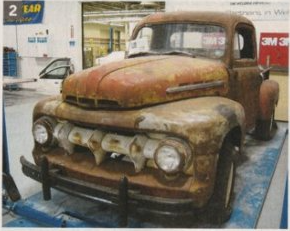
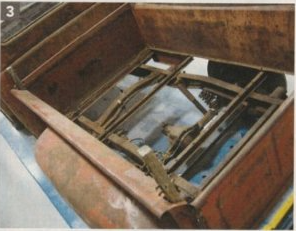
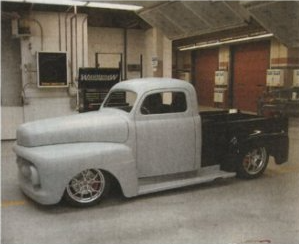
In the end, Sobbry’s students used just three parts from the Lillys’ truck – part of the cab, the front grille, albeit modified, and the metal piece between the fenders and hood. What remains is a testament to what is possible when creativity and generosity collide. Many hands contributed to the truck’s customization process. Among those who helped was Gene Winfield, a famous California custom car builder who was honored at the 2008 Autorama as Builder of the Year. Here are pictures of the legend at 80 years of age chopping down the top of Lillys’ truck.
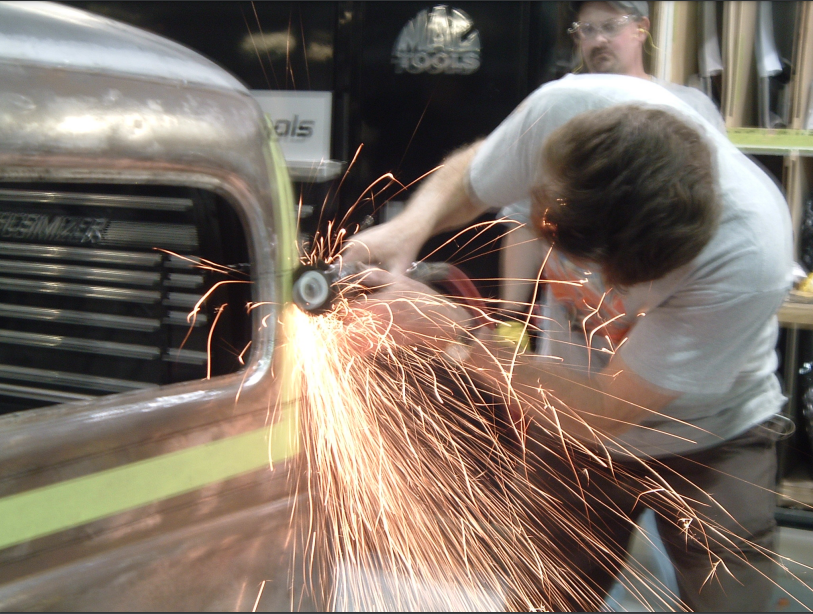
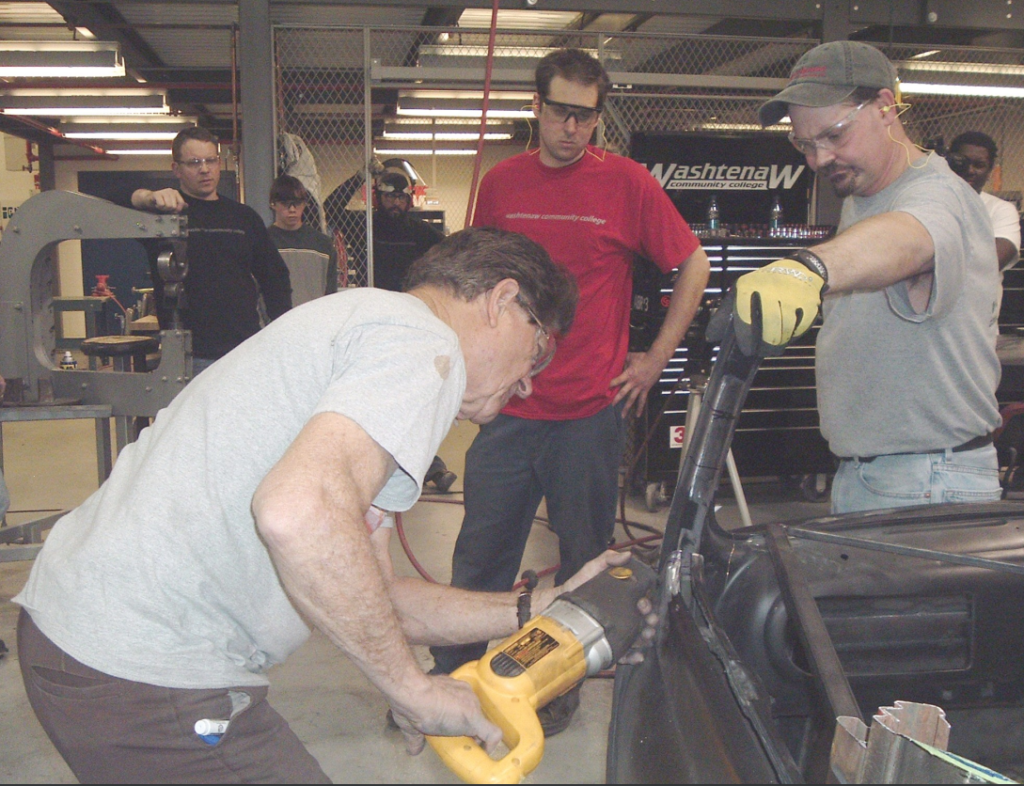
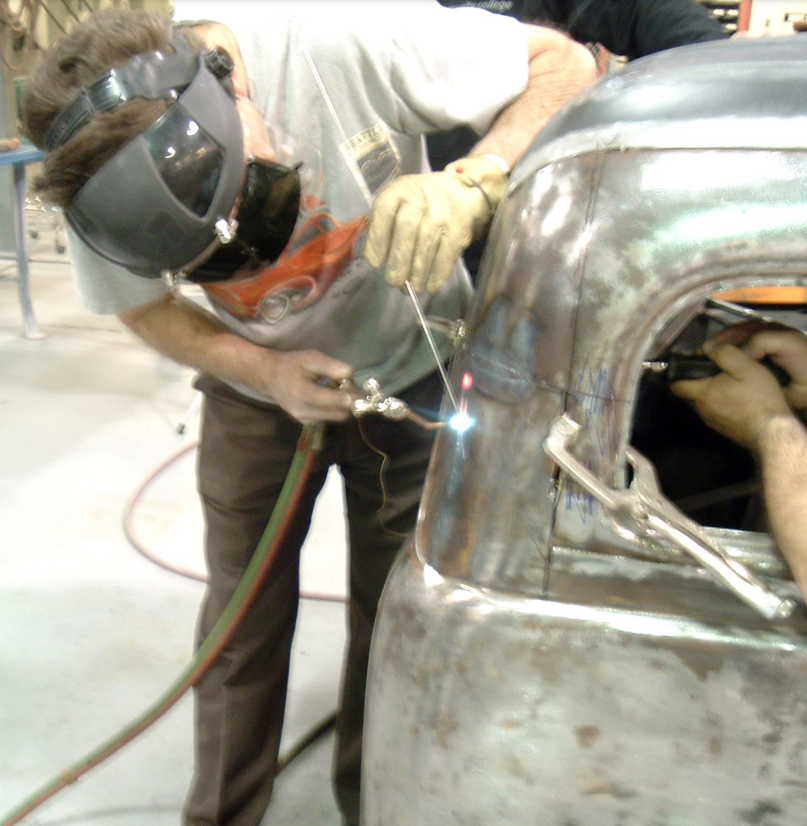
A ’48 truck cab was used for the greenhouse and part of the cowl. Once the new metal was welded into place it looked almost like a truck again. The rear fenders were widened a couple of inches to cover the 12-inch-wide rear tire intended for the truck. Gene Winfield and the WCC team chopped the top 2-inches but kept the same rear window height. Bob’s Classic Auto Glass stepped up and supplied tinted glass to fit the cab’s new profile.
Headlight buckets were frenched into the center of the grille, and the grille teeth were shortened to float in the grille opening. Most of the remaining body pieces came from Pro’s Pick, including a new steel bed, tailgate, roll pan, tonneau cover, and running boards as well as fiberglass fenders, both front and rear. Other exterior modifications include a custom fiberglass hood from Fairlane Company and Auto-Loc suicide door hinges and bear-claw latches added after the doors were reinforced.
The door handles, bumpers, drip rails, and fuel door were all removed by the students. In place of the bumpers, students installed a roll pan with LED lights for the rear, and a handmade valance for the front all to bring Justin’s vision of a sleek hot-rod to life. The team then spray-painted the truck PPG DCC 9000 Black on every facet before dousing the body in a clear coat, giving it that mirror shine. When the body was back from the paint booth and buffed to a high gloss, Steele Rubber weatherstripping was installed to seal the doors and hood, and a Painless Wiring harness connected all the important electrical components.
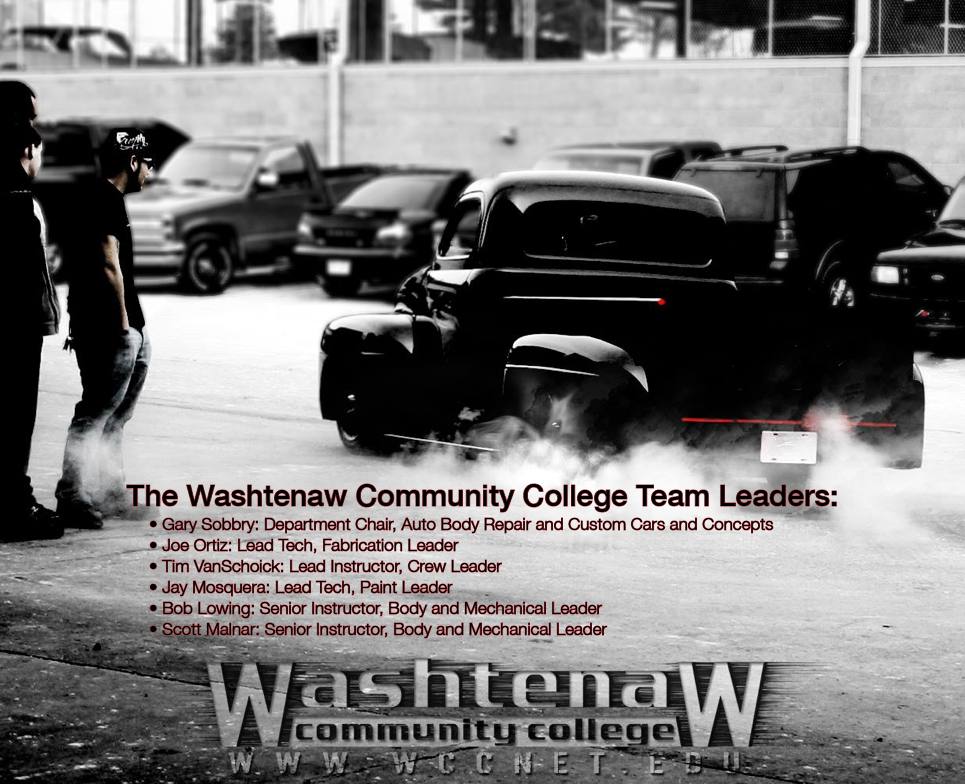
As you can see, the result is simply spectacular. The WCC transformed the rusty old hooptie into a head turning sleek black beauty. Grandpa’s truck now features a leather interior, custom rims, a complete stereo system and a 4.6-liter, supercharged motor that can produce more than 600 horsepower. The truck, which Sobbry estimated upon its completion was worth $250,000.
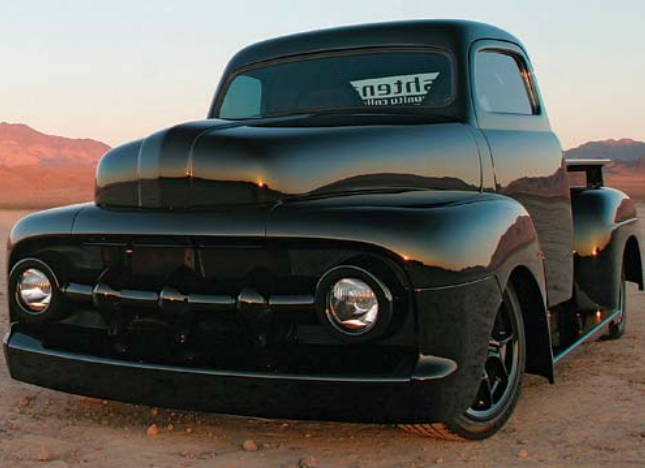
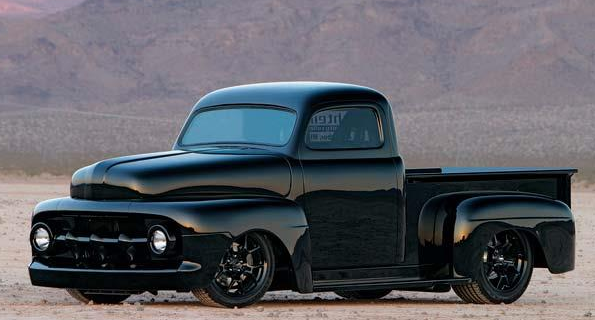
This sleek new ride was presented to Justin on the first day of the 2007 Detroit Autorama show at Cobo Center in Detroit.
This truly historical and one-of-a-kind truck is available in our St. Louis Showroom. Click here for more information, photos, and a video.
Gateway Classic Cars sells and consigns hundreds of vehicles each month. Do you have a classic car for sale with a story to tell? We’d love to hear about it, please email us at news@gatewayclassiccars.com to share it.
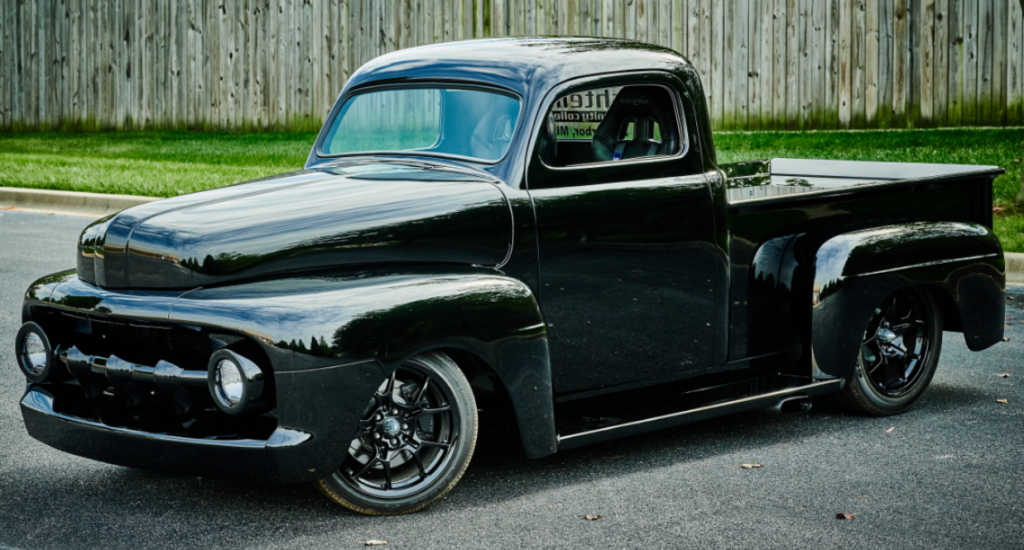
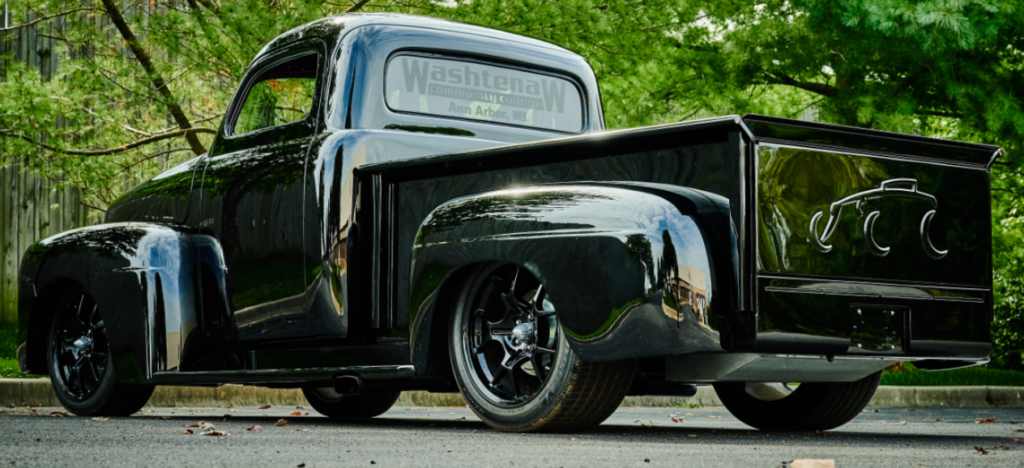
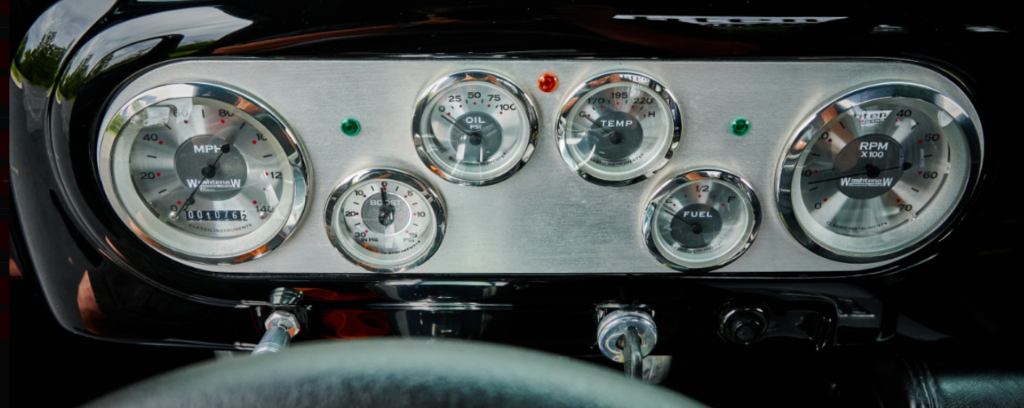
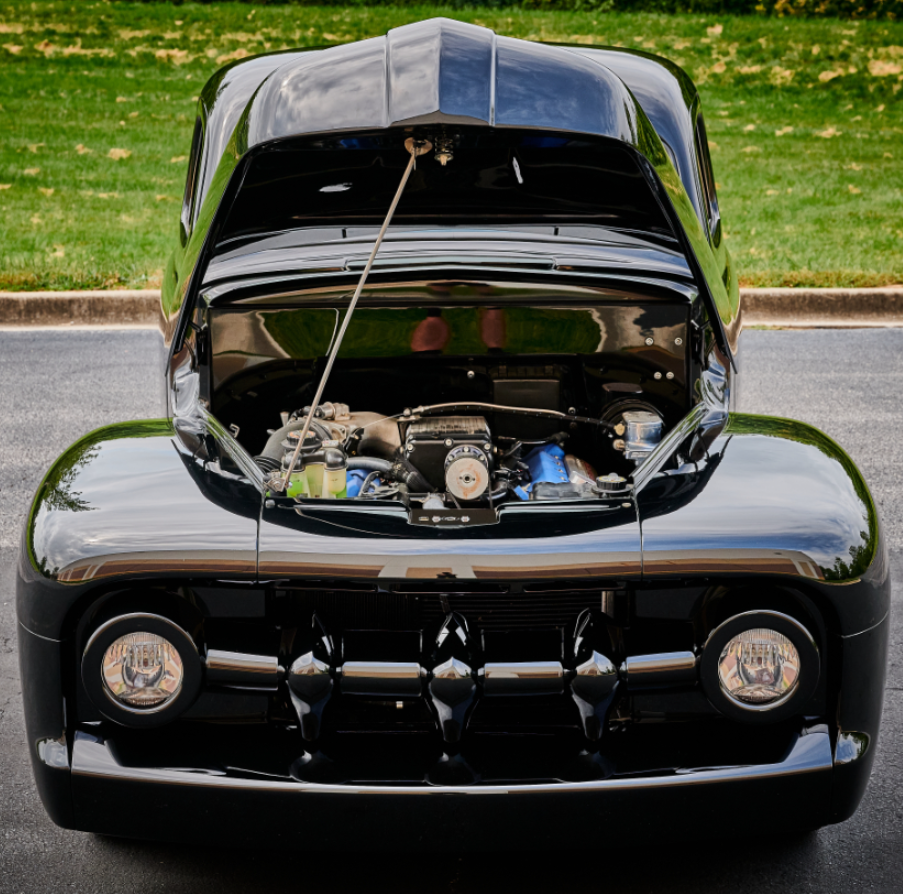
Sources:
- April 29, 2005 Ford Communications Network Press Release – ‘One Cop Car (and a Lincoln) That Everyone Else Will be Pursuing’
- July 2005 – August 2005 Police Fleet Manager Vol. 4; No. 4 – ‘CVPI and One Lap of America’
- August 2005 CARandDRIVER – ‘2005 Cannonball One Lap of America: The Four-Second Factor’
- November 1, 2005 MotorTrend – ‘Inside The OEs – 2003 Mercury Marauder’
- December 2005 Muscle Machines Hemmings Feature – ‘LAPD’s Finest’
- February 12, 2006 The Jackson Citizen Patriot – ‘Make-A-Wish, college to help restore ’51 Ford pickup’
- August 30, 2006 PR Newswire US – ‘LA Deputy Sheriff ‘Nabbed’ for Dunlop Drivers Cup’
- October 15, 2006 Ann Arbor News – ‘Wish has 608 horsepower’
- March 6, 2008 Detroit Free Press – ‘Truck Genies: Student’s Wish Granted When Old Family Pickup Gets Custom Makeover’
- March 10, 2008 TrucknMag Vol.34-No.4 – ‘Washtenaw Community College and Ford Team Up for a Good Cause’

Comments